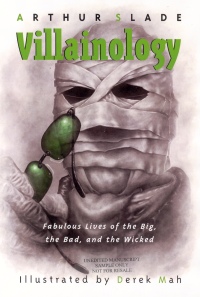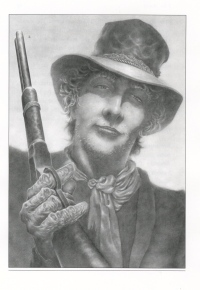| ________________
CM . . .
. Volume XIV Number 3 . . . .September 28, 2007 
 |
Villainology: Fabulous Lives of the Big, the Bad, and the Wicked.
Arthur Slade. Illustrated by Derek Mah.
Toronto, ON: Tundra, 2007.
95 pp., pbk., $12.99.
ISBN 978-0-88776-809-5.
Subject Headings:
Villains in popular culture-Juvenile fiction.
Villains in literature-Juvenile fiction.
Children's stories, Canadian (English).
Grades 4-7 / Ages 9-12.
Review by Shannon Ozirny.
***½ /4
Reviewed from Advance Reading Copy.
|
| |
|

excerpt:
The big, good wolf: Not all stories have wolves as sneering, evil carnivores. In Native American mythology the wolf is portrayed as brave, full of honor (not full of children or grandmas), and intelligent. According to Roman mythology, Romulus and Remus, two warriors, were raised by a female wolf (actually they were nursed by the wolf, but that's too gross to mention). The two men went on to found Rome, the city that gave us the Roman Empire. So where would the Roman Empire be without the wolf, hey?
Arthur Slade gets kid humor. While adults may groan at the puns and one-liners in Slade's latest release, Villainology, children will huff and puff with laughter while reading profiles on infamous characters like The Headless Horseman, Scarface Capone, Morgan le Fay, and of course, The Big Bad Wolf.
Villainology can best be described as a tongue-in-cheek, informational comedy routine aimed at kids in the height of their scamp stage. This is kid wit for the future sitcom writer or hip advertising executive. English teachers will likely cringe at the sentence fragments and trendy vernacular but rejoice when their students unknowingly learn about Shakespeare, Marlowe, H.G. Wells, Arthurian legend, and Greek mythology. After all, where else can kids get the lowdown on the Shakespeare villains, the Phantom of the Opera, or Mephistopheles without reading the weighty source material? Thanks to Villainology, kids can experience the juicy bits about Attila the Hun, Billy the Kid, Qin Hui, and Emperor Nero before they begin to formally study the topics in later grades. In other words, Villainology is the ultimate literary gateway drug.
 Although interesting facts abound (did you know Ebenezer Scrooge was based on a real-life Scot named Ebenezer Lennox Scroggie?), Villainology's truthful tidbits are sometimes too cleverly hidden in humor. In fact, I'm afraid to list any more facts from Villainology for fear that I will embarrass myself by quoting a known piece of fiction. Hopefully, Tundra will find a better way to delineate between fact and fiction in future "-ology" books.
Although interesting facts abound (did you know Ebenezer Scrooge was based on a real-life Scot named Ebenezer Lennox Scroggie?), Villainology's truthful tidbits are sometimes too cleverly hidden in humor. In fact, I'm afraid to list any more facts from Villainology for fear that I will embarrass myself by quoting a known piece of fiction. Hopefully, Tundra will find a better way to delineate between fact and fiction in future "-ology" books.
Derek Mah's black-and-white illustrations are scarily playful and thoughtful. Kids will surely not miss color in these pictures; in fact, the black-and-white drawings add to the "textbook gone psycho" tone of this twisted information book. The vivacity and delicious strangeness of Mah's drawings suggests that he has the enviable talent of entering a 10-year-old's mind.
"Ssshhhing" librarians beware - this book is a "huddler." In other words, expect your younger patrons to peruse Villainology in hysterical huddles of three or four. Slade's humor is best served in a group setting, and kids will likely repeat the jokes until your ssshhing finger spasms and cramps. However, librarians and other adult brainiacs will most likely chuckle when they learn that The Headless Horseman "briefly date[d] the ghost of Marie Antoinette."
Highly Recommended.
Shannon Ozirny is a student in the Master of Children's Literature program at UBC. As for her favourite villain, she has always been wary of Mr. McGregor and his garden.

To comment
on this title or this review, send mail to cm@umanitoba.ca.
Copyright © the Manitoba Library Association. Reproduction for personal
use is permitted only if this copyright notice is maintained. Any
other reproduction is prohibited without permission.
NEXT REVIEW |
TABLE OF CONTENTS FOR THIS ISSUE
- September 28, 2007.
AUTHORS |
TITLES |
MEDIA REVIEWS |
PROFILES |
BACK ISSUES |
SEARCH |
CMARCHIVE |
HOME |

 Although interesting facts abound (did you know Ebenezer Scrooge was based on a real-life Scot named Ebenezer Lennox Scroggie?), Villainology's truthful tidbits are sometimes too cleverly hidden in humor. In fact, I'm afraid to list any more facts from Villainology for fear that I will embarrass myself by quoting a known piece of fiction. Hopefully, Tundra will find a better way to delineate between fact and fiction in future "-ology" books.
Although interesting facts abound (did you know Ebenezer Scrooge was based on a real-life Scot named Ebenezer Lennox Scroggie?), Villainology's truthful tidbits are sometimes too cleverly hidden in humor. In fact, I'm afraid to list any more facts from Villainology for fear that I will embarrass myself by quoting a known piece of fiction. Hopefully, Tundra will find a better way to delineate between fact and fiction in future "-ology" books.